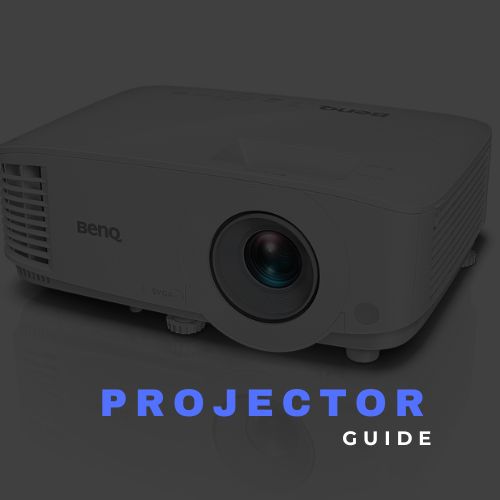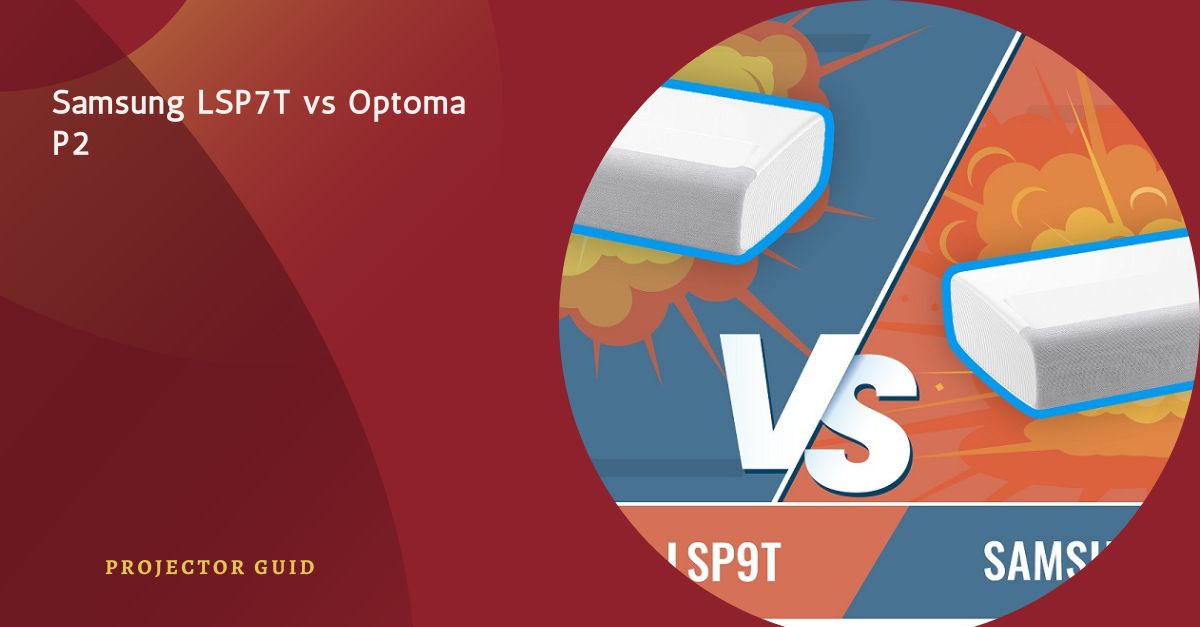When I set up my home theater, I thought any screen would work fine. But after trying matte white, gray, and ALR screens, I saw a big difference. The ALR screen looked better during the day, while the matte white was great at night. This helped me understand how important screen material really is.
Projector screens come in different materials like matte white, gray, and ALR. Projector Screen Materials Comparison Each one works better in different lighting, from dark rooms to bright spaces. Knowing the difference helps you pick the best screen for clear and bright images.
Stick with us—we’re going to talk about projector screen materials comparison in a simple way, so you can pick the right screen without any confusion.
Is An Ultra-Short-Throw Projector A Good Substitute For A Big-Screen Tv?
An ultra-short-throw projector can work well instead of a big-screen TV. It sits close to the wall and still shows a large, clear picture. This is great for small rooms where space is limited.
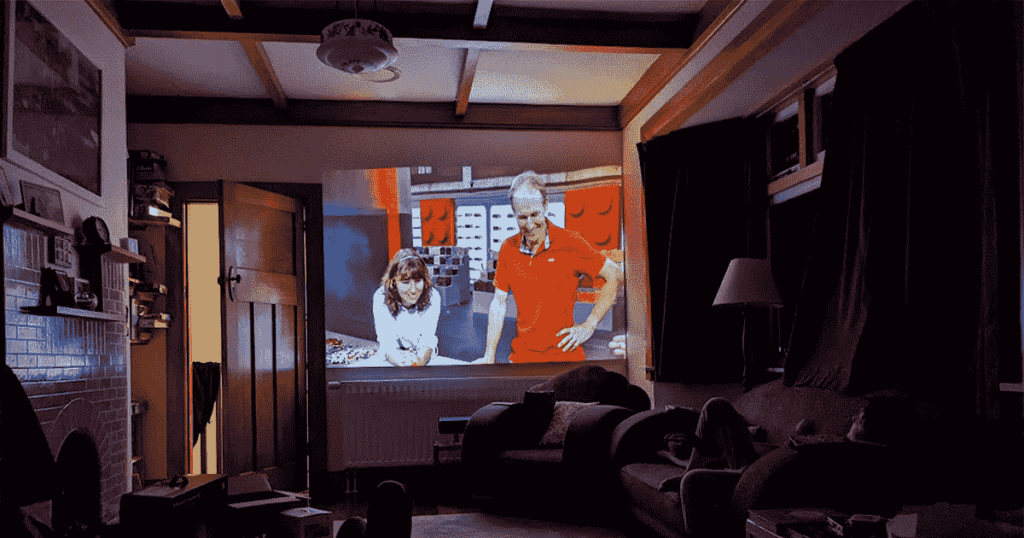
But the screen you use matters a lot. That’s why a projector screen materials comparison helps. Some screens, like ALR, work better in bright rooms, while others like matte white are good in the dark. Picking the right screen makes the picture look much better.
What Does Alr Mean In Screen Materials?
ALR stands for Ambient Light Rejecting. It’s a special type of screen material that helps reduce the impact of light in your room. This means the picture stays clear and bright, even when there’s some light in the room.
In a projector screen materials comparison, ALR screens are great for spaces with natural or artificial light. They make sure the image looks sharp, even if you can’t completely control the lighting around you.
Read: Led Projectors Need Maintenance – Tips For Longevity!
What Types Of Materials Are Used To Make Projector Screens?
Projector screens come in different materials to suit various needs. Common ones include matte white, gray, and ambient light-rejecting (ALR) screens. Matte white is great for dark rooms, while gray screens help with contrast in rooms that aren’t completely dark.
In a projector screen materials comparison, ALR screens are ideal for bright rooms because they reduce the impact of extra light. Each material has its strengths, depending on your space and how you want the picture to look.
- Fixed Frame Projection Screen: A fixed frame projection screen offers a sturdy, permanent setup with a flat, wrinkle-free surface. It’s ideal for home theaters where the screen doesn’t need to be moved.
- Pull Up and Pull Down Retractable Screens: These retractable screens are easy to store, pulling up or down as needed. They’re great for spaces where the screen is used occasionally and stored when not in use.
- Ceiling-Mounted Pull Down Screens: Ceiling-mounted pull-down screens are mounted above, and can be pulled down for use. They’re perfect for saving space and keeping the screen out of sight when not in use.
- Floor Rising Pull Up Screens: Floor rising screens pop up from the ground when needed. They’re convenient for temporary setups, especially in rooms where ceiling-mounted screens aren’t an option.
- Tab-Tensioned Projection Screen: Tab-tensioned screens have tensioning cords that keep the surface flat. This is perfect for getting a smooth, wrinkle-free image every time.
- Electric Projection Screen: Electric screens automatically roll up and down at the touch of a button. They offer the convenience of easy storage and setup, often with a sleek, modern design.
How Does Fabric Vs Pvc Screen Material Compare?
Fabric screens are lightweight and flexible, making them a good option for home setups. They work well in dark rooms and are easier to manage for DIY projector screens.
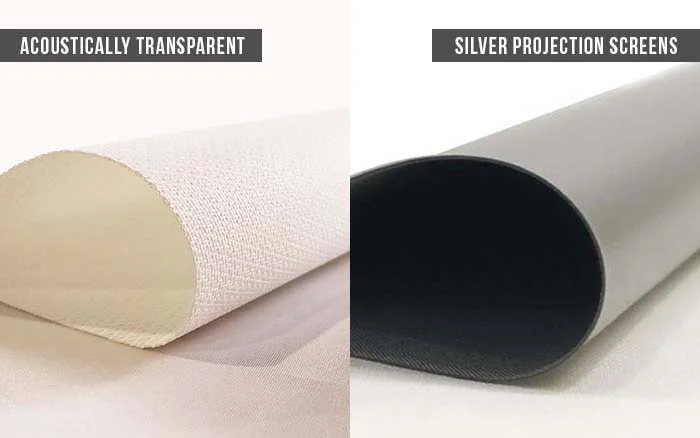
In a projector screen materials comparison, PVC screens are more durable and provide a smoother surface. They offer brighter images, which makes them better for rooms with more light. Each type has its benefits, depending on your room’s lighting and what you want from your screen.
Does Screen Texture Affect Image Quality?
Yes, the texture of a projector screen can affect how clear the image looks. Smooth screens usually give sharper, clearer pictures, while textured ones can make the image appear a bit softer or distorted.
In a projector screen materials comparison, the texture helps control how light is reflected. Screens with special coatings or textures, like matte or high-gain, can improve brightness and contrast, depending on the light in your room.
Read: Projector Screen Size Guide – Ultimate Guide!
What Is The Best Material For A Homemade Projector Screen?
For a homemade projector screen, the best material is usually something simple like matte white fabric. It’s affordable and works well in dark rooms, giving you a clear picture.
In a projector screen materials comparison, matte white is a good choice for a DIY screen. However, if your room has more light, you might want to try gray or special ALR materials for better image quality. These options can give you a brighter, sharper picture.
- Best Projector Screen Material Indoors: Matte white is often considered the best indoor projector screen material, providing great color accuracy and sharpness in dark rooms. For brighter environments, an ALR screen is a good choice, as it reduces ambient light interference.
- Best Projector Screen Material Outdoors: For outdoor use, screens made from PVC or special weather-resistant fabrics work best, as they can handle different weather conditions. ALR or gray screens can also help reduce glare from sunlight, improving the picture quality.
- Best Projector Screen Overall: The best overall projector screen material depends on your needs, but an ALR screen is ideal for versatility, offering great performance in both bright and dark rooms. It balances brightness, contrast, and clarity for various viewing setups.
Can Screen Material Improve Brightness?
Yes, the material of your projector screen can make the image brighter. Screens with higher gain reflect more light, making the picture look clearer and more vibrant, even in rooms with some light.
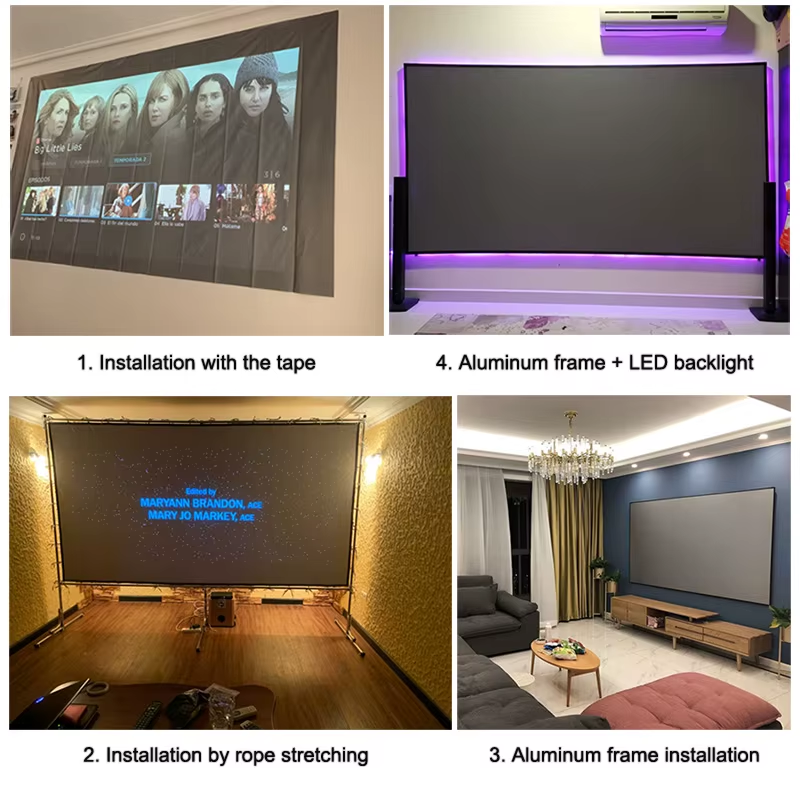
In a projector screen materials comparison, materials like matte white and high-gain fabrics help boost brightness. Picking the right screen for your room can improve how bright and clear the picture looks, whether your space is dark or has some light.
Is Gray Screen Better Than White For Contrast?
Gray screens are better than white for contrast, especially in rooms with some light. The gray helps make dark areas look deeper, which makes the colors stand out more.
In a projector screen materials comparison, gray screens are great for rooms that aren’t completely dark. They improve contrast by making blacks look richer and colors more vibrant, while white screens work best in dark spaces.
Read: Projector Not Displaying Image – Fix It Fast!
Which Projector Screen Material Is Best For Daylight Use?
For daylight use, ambient light rejecting (ALR) screens are the best option. They are designed to keep the image bright and clear by reducing the impact of surrounding light in the room.
In a projector screen materials comparison, ALR screens are perfect for bright rooms. They help maintain the brightness and color of the image, even when there’s a lot of daylight.
- Ambient Light Rejecting (ALR) Screens: ALR screens are specifically designed to handle ambient light. They reflect light from the projector while blocking unwanted light from the surroundings, making them perfect for daylight use.
- High Contrast Gray Screens: Gray screens absorb excess ambient light, improving black levels. They offer better contrast in brighter rooms, making them a good choice for daylight environments.
- Matte White Screens: Matte white screens work well in dark rooms but struggle with ambient light. They are less ideal for daylight use but can still perform reasonably well in moderately lit spaces.
- Silver or High Gain Screens: High-gain silver screens reflect more light, making them brighter. These materials help improve visibility in rooms with some natural light, but they may reduce contrast slightly.
Which Screen Type Works Best In Dark Rooms?
In dark rooms, matte white screens are the best choice. They show clear pictures with true colors since there’s no outside light to disturb the image.
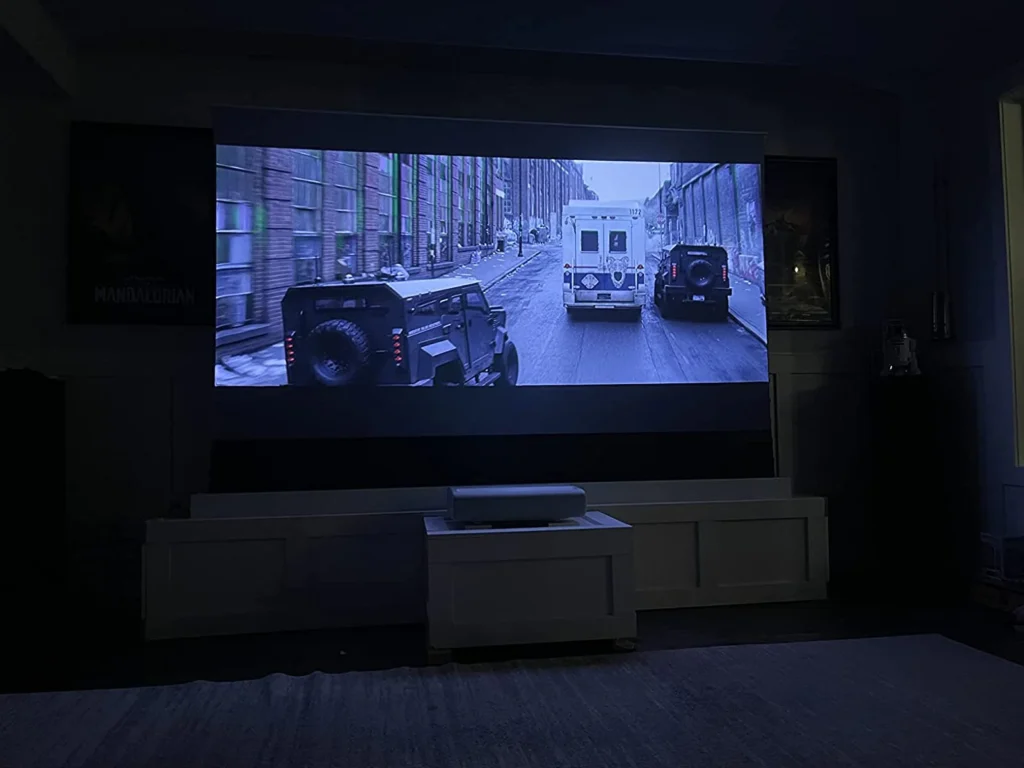
In a projector screen materials comparison, matte white screens are perfect for dark spaces. They give a clean, bright, and balanced view, which makes movie nights look amazing.
What Screen Material Is Best For 4k Projectors?
For 4K projectors, a smooth and high-quality screen material is best. Materials like PVC or special tensioned fabric with no texture help show sharp details and rich colors that 4K offers.
In a projector screen materials comparison, screens made for 4K give the clearest image. They keep the picture sharp and clean, so you can enjoy all the tiny details that make 4K look so real.
Read: Lumens In Projectors Explained – Clear Guide With Examples!
Are Expensive Screen Materials Worth It?
Sometimes expensive screen materials are worth the money, especially if you want the best movie or gaming experience. They often show brighter images, better contrast, and true colors.
When doing a projector screen materials comparison, you’ll notice that costly screens usually perform better. But if you only watch movies now and then, a cheaper one may still do a good job.
- Shows Clearer Picture
Expensive screens give sharp images with rich colors and smooth texture. - Works Well in Any Light
They handle both bright and dark rooms better than cheap screens. - Made to Last Longer
High-quality screen materials don’t wrinkle easily and stay flat for years. - Great for 4K and HD
In a projector screen materials comparison, premium screens bring out more detail in 4K projectors.
Can Screen Material Reduce Glare?
Yes, the right projector screen material can reduce glare. Special materials like ALR help block extra light, so you get a clearer image without bright spots.

In a projector screen materials comparison, ALR and matte white screens do a great job of cutting down glare. They keep the image sharp, even if there’s some light in the room.
FAQs:
Q1. What Is The Best Surface To Project Onto?
The best surface for projection is a smooth, light-colored one like a white wall or projector screen. A flat, even surface ensures clarity and sharpness of the image. Avoid textured or dark surfaces, as they can distort or dull the projection.
Q2. Does Projector Screen Material Matter?
Yes, projector screen material plays a crucial role in image quality. Different materials affect brightness, contrast, and color accuracy. Choosing the right material ensures the best viewing experience, whether you’re in a dark or bright room.
Q3. What Material Makes The Best Projector Screen?
Matte white is popular for home use, offering balanced brightness and color. ALR (Ambient Light Rejecting) screens are ideal for bright rooms, while gray screens enhance contrast in darker settings. The choice depends on your room’s lighting conditions.
Q4. What Fabric Is Best For A Projector Screen?
Fabric like PVC and woven fabrics are commonly used for projector screens. PVC is durable and provides a smooth, reflective surface, while woven fabric offers a more textured finish with minimal light loss. The best fabric depends on the environment and desired screen size.
Q5. What Is The 4-6-8 Rule For Projectors?
The 4-6-8 rule suggests the optimal distance between your projector, screen, and viewer for the best image quality. Typically, the projector should be placed 4 feet from the screen, and the viewer should sit 6 to 8 feet away. Following this rule helps ensure proper image scaling and viewing comfort.
Q6. Which Is Better, Alr Or Clr Screens?
ALR screens are great for bright rooms, as they reject ambient light, ensuring a clear image. CLR screens, on the other hand, are designed for ceiling-mounted projectors and work well in high-ceiling rooms. ALR is generally better for typical home theater setups with ambient light.
Conclusion:
In conclusion, picking the right projector screen material makes a big difference in your viewing experience. Whether it’s matte white, gray, or ALR, each material works better in different lighting conditions.
Comparing these options helps you choose the best one for your space. Factors like brightness, contrast, and light control should guide your decision. Taking time to compare projector screen materials ensures the best results for your setup.
Read More:
- Projector On Angled Wall – Fix Distortions Easily!
- Are Portable Projectors Reliable – Complete Guide!
- Do Projectors Need A Dark Room – Find Out Now!
- Optoma Projector User Guide – Complete Guide!
- Best Distance For Projector Placement – Easy Guide!
- Common Projector Issues And Fixes – Easy Steps!
- Infocus Projector User Guide – Easy Tips!
- Hdcp 2.2 Workaround For Projector – Find Easy Solution!
